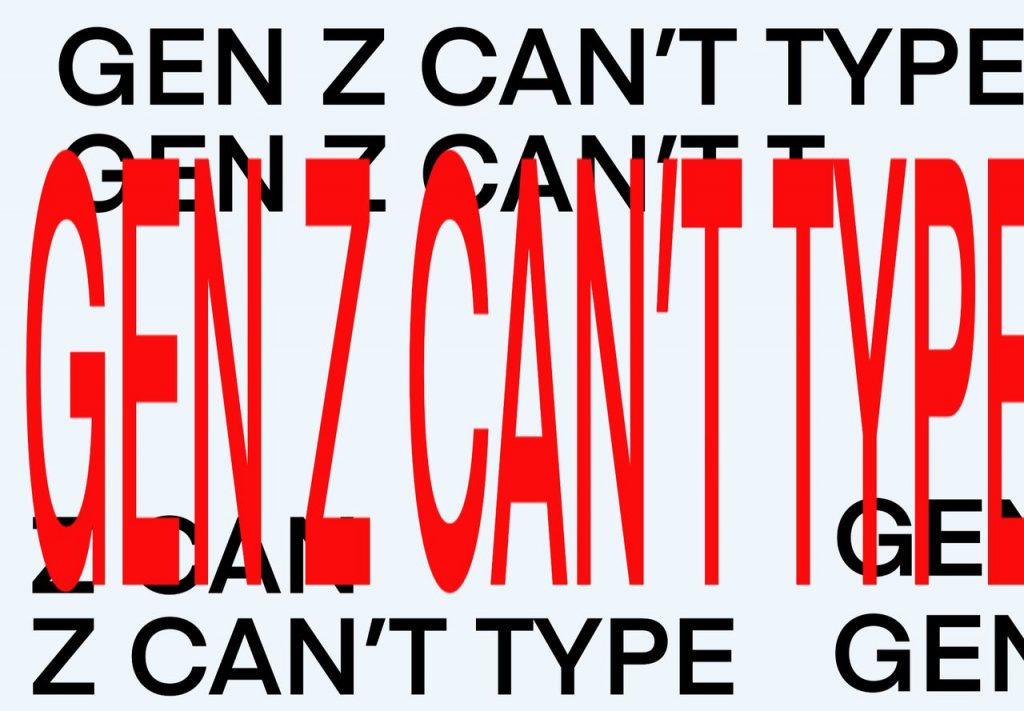When Lola Reinhardt opened her laptop and began to edit her business website, she saw her stepmother roll her eyes. Reinhardt, a 24-year-old freelance photographer and part-time barista in Seattle, was staring at her computer and scanning the keyboard for her next letter, since she doesn’t know how to touch-type.
“Kids these days,” Reinhardt recalls hearing from her stepmother, a prolific romance author who was busy typing “a million miles a minute.” Reinhardt says she giggled and offered her defense: in all her years of school, she was never taught typing.
Reinhardt represents the legions of tech-savvy Gen Z, born between 1997 and 2012, who can do anything on a computer—except type without looking at the keys.
In April, the 22-year-old singer Billie Eilish told Rolling Stone: “I never learned to type because I wasn’t that generation, and now I regret it.”
Over the past 25 years, the number of U.S. high schools teaching typing has fallen drastically. While about 44% of students who graduated high school in 2000 took a keyboarding course, by 2019 that figure had plummeted to 2.5%, according to the U.S. Department of Education.

Online ‘almost constantly’
Educators sometimes assume Gen Z digital natives already know how to type because they’re so familiar with tech. After all, nearly half of teens say they are online “almost constantly,” according to a survey from Pew Research Center.
But while today’s students have greater access to laptops, tablets and smartphones, that access doesn’t automatically translate into typing skills.
When Christine Mueller was an employee in Oklahoma City’s educational tech-services department, she decided to stage an intervention. She had heard from teacher after exasperated teacher about the city’s third-graders. The school district provided laptops to those children, but didn’t offer a dedicated time for students to learn to type.
So Mueller introduced Oklahoma City’s first spelling-bee style keyboarding competition, called the “Key Bee,” to recognize public schools’ speediest student typists. She hoped the children would rise to the occasion and practice.
On the day of the competition, the Oklahoma City Thunder basketball team mascot, Rumble the Bison, joined to cheer on the typists.
The fastest student clocked in at 91 words a minute. And more broadly, the practice paid off. One fourth-grade teacher said the average typing speed for students in her class increased to 25 words a minute from 13 words a minute.
Some school districts offer more formal typing instruction when they introduce students to Chromebooks, but curriculum varies.
Jonah Maier, 23, learned to type in seventh grade, but says he still watches his keyboard to make sure he hits the right letters. Every couple sentences he reads over his lines to double-check his work.
Typing got particularly tiring when Maier was working on the capstone paper for his college literature review about human characteristics in artificial intelligence. About halfway through the 20-page paper, he tried dictating the words using speech-to-text software.
The tool inserted too many grammatical errors. “It was so tedious,” Maier said. He finished his paper the old-fashioned way: typing it out on his laptop.
Other students prefer the screens on their iPads, essentially bigger versions of their smartphones, to physical keyboards. The ubiquity of the tablets in schools make it easier for Gen Z to avoid computer keyboards altogether.
Paige DeChaney, 18, learned to type on computer keyboards in elementary school, but has since logged more hours typing on the iPad her district in Morton, Ill., lent out from seventh grade through high school.
This past semester, she wrote an eight-page memoir for class, typing it all on her iPad. She knows the layout of the keyboard on the iPad screen, and uses all her fingers to type quickly.
“I have gotten weird looks for typing on my iPad screen,” DeChaney said.
Students are submitting a growing portion of their assignments from mobile devices. Between March and May, 39% of the assignments that students submitted through the online platform Canvas were uploaded from mobile devices. Schools use Canvas to distribute content to students and as a place for students to turn in coursework.
“What students want to do is do the work on their mobile devices,” said Melissa Loble, chief academic officer at Instructure, the company that makes Canvas.
Teachers, meanwhile, completed more than 90% of their work on Canvas on a computer. “We have two generations experiencing the teaching, and the learning, in a very different way,” she said. “That’s alarming to me.”
As more states move their analog standardized tests to computers, Tim Dikun, COO at Teaching.com, the parent company of Typing.com, says he expects more schools to reprioritize typing education.
“Students will have higher test scores when they don’t have to think about how to type and can think about the content they are creating,” he said.
Already, Dikun says Typing.com has seen increased demand for typing education programs in states such as New York and Texas that are implementing computer-based exams.
‘Secret knowledge’
Sofia Strandy, the 16-year-old daughter of an employee at Typing.com, started practicing soon after her father joined the company about seven years ago. Since then, she has achieved typing speeds of 95 words a minute.
She doesn’t mention this typing prowess to peers. “It feels like I have access to secret knowledge.”
Some of her fellow Gen-Zers still would like to learn. Rueben Tasler, 17, said he currently hunts and pecks on the keyboard, but hopes to teach himself to type before he heads to college.
“Maybe once I learn to type I’ll look back and wish I’d learned sooner,” Tasler said. “I know it’ll be more efficient—then I could look down at the keyboard less often.”
Write to Georgia Wells at georgia.wells@wsj.com






